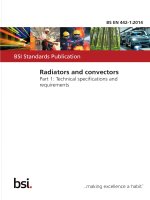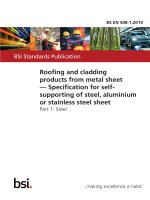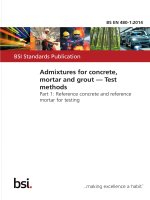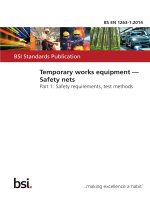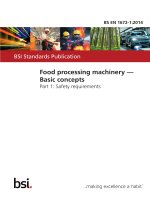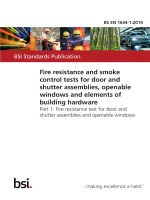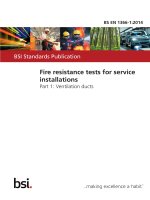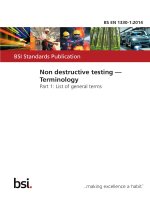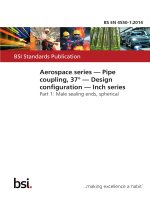Bsi bs en 61158 1 2014
Bạn đang xem bản rút gọn của tài liệu. Xem và tải ngay bản đầy đủ của tài liệu tại đây (1.96 MB, 78 trang )
BS EN 61158-1:2014
BSI Standards Publication
Industrial communication
networks — Fieldbus
specifications
Part 1: Overview and guidance for the
IEC 61158 and IEC 61784 series
BS EN 61158-1:2014 BRITISH STANDARD
National foreword
This British Standard is the UK implementation of EN 61158-1:2014. It is
identical to IEC 61158-1:2014. It supersedes PD CLC/TR 61158-1:2010 which
is withdrawn.
The UK participation in its preparation was entrusted to Technical
Committee AMT/7, Industrial communications: process measurement and
control, including fieldbus.
A list of organizations represented on this committee can be obtained on
request to its secretary.
This publication does not purport to include all the necessary provisions of
a contract. Users are responsible for its correct application.
© The British Standards Institution 2014.
Published by BSI Standards Limited 2014
ISBN 978 0 580 79254 0
ICS 25.040.40; 33.040; 35.100.05
Compliance with a British Standard cannot confer immunity from
legal obligations.
This British Standard was published under the authority of the
Standards Policy and Strategy Committee on 31 October 2014.
Amendments/corrigenda issued since publication
Date Text affected
EUROPEAN STANDARD EN 61158-1
NORME EUROPÉENNE
EUROPÄISCHE NORM September 2014
Supersedes CLC/TR 61158-1:2010
ICS 25.040.40; 33.040; 35.100.05
English Version
Industrial communication networks - Fieldbus specifications -
Part 1: Overview and guidance for the IEC 61158 and IEC 61784
series
(IEC 61158-1:2014)
Réseaux de communication industriels - Spécifications des Industrielle Kommunikationsnetze - Feldbusse -
bus de terrain - Partie 1: Présentation et lignes directrices Teil 1: Überblick und Leitfaden zu den Normen der Reihe
des séries CEI 61158 et CEI 61784 IEC 61158 und IEC 61784
(CEI 61158-1:2014) (IEC 61158-1:2014)
This European Standard was approved by CENELEC on 2014-06-27. CENELEC members are bound to comply with the CEN/CENELEC
Internal Regulations which stipulate the conditions for giving this European Standard the status of a national standard without any alteration.
Up-to-date lists and bibliographical references concerning such national standards may be obtained on application to the CEN-CENELEC
Management Centre or to any CENELEC member.
This European Standard exists in three official versions (English, French, German). A version in any other language made by translation
under the responsibility of a CENELEC member into its own language and notified to the CEN-CENELEC Management Centre has the
same status as the official versions.
CENELEC members are the national electrotechnical committees of Austria, Belgium, Bulgaria, Croatia, Cyprus, the Czech Republic,
Denmark, Estonia, Finland, Former Yugoslav Republic of Macedonia, France, Germany, Greece, Hungary, Iceland, Ireland, Italy, Latvia,
Lithuania, Luxembourg, Malta, the Netherlands, Norway, Poland, Portugal, Romania, Slovakia, Slovenia, Spain, Sweden, Switzerland,
Turkey and the United Kingdom.
European Committee for Electrotechnical Standardization
Comité Européen de Normalisation Electrotechnique
Europäisches Komitee für Elektrotechnische Normung
CEN-CENELEC Management Centre: Avenue Marnix 17, B-1000 Brussels
© 2014 CENELEC All rights of exploitation in any form and by any means reserved worldwide for CENELEC Members.
Ref. No. EN 61158-1:2014 E
BS EN 61158-1:2014
EN 61158-1:2014 - 2 -
Foreword
The text of document 65C/757/FDIS, future edition 1 of IEC 61158-1, prepared by SC 65C “Industrial
networks” of IEC/TC 65 “Industrial-process measurement, control and automation" was submitted to
the IEC-CENELEC parallel vote and approved by CENELEC as EN 61158-1:2014.
The following dates are fixed:
• latest date by which the document has to be (dop) 2015-03-27
implemented at national level by (dow) 2017-06-27
publication of an identical national
standard or by endorsement
• latest date by which the national
standards conflicting with the
document have to be withdrawn
This document supersedes CLC/TR 61158-1:2010.
Attention is drawn to the possibility that some of the elements of this document may be the subject of
patent rights. CENELEC [and/or CEN] shall not be held responsible for identifying any or all such
patent rights.
This document has been prepared under a mandate given to CENELEC by the European Commission
and the European Free Trade Association.
Endorsement notice
The text of the International Standard IEC 61158-1:2014 was approved by CENELEC as a European
Standard without any modification.
In the official version, for Bibliography, the following notes have to be added for the standards indicated:
IEC 60793-2-30:2012 NOTE Harmonized as EN 60793-2-30:2013 (not modified).
IEC 60793-2-40:2009 NOTE Harmonized as EN 60793-2-40:2011 (not modified).
IEC 61000-6-2 NOTE Harmonized as EN 61000-6-2.
IEC 61131-2 NOTE Harmonized as EN 61131-2.
IEC 61158 Series NOTE Harmonized as EN 61158 Series (not modified).
IEC 61158-2:2014 NOTE Harmonized as EN 61158-2 1) (not modified).
IEC 61158-3-1:2014 NOTE Harmonized as EN 61158-3-1 1) (not modified).
IEC 61158-3-2:2014 NOTE Harmonized as EN 61158-3-2 1) (not modified).
IEC 61158-3-3:2014 NOTE Harmonized as EN 61158-3-3 1) (not modified).
IEC 61158-3-4:2014 NOTE Harmonized as EN 61158-3-4 1) (not modified).
IEC 61158-3-7:2007 NOTE Harmonized as EN 61158-3-7:2008 (not modified).
IEC 61158-3-8:2007 NOTE Harmonized as EN 61158-3-8:2008 (not modified).
IEC 61158-3-11:2007 NOTE Harmonized as EN 61158-3-11:2008 (not modified).
IEC 61158-3-12:2014 NOTE Harmonized as EN 61158-3-12 1) (not modified).
IEC 61158-3-13:2014 NOTE Harmonized as EN 61158-3-13 1) (not modified).
IEC 61158-3-14:2014 NOTE Harmonized as EN 61158-3-14 1) (not modified).
IEC 61158-3-16:2007 NOTE Harmonized as EN 61158-3-16:2008 (not modified).
1) To be published.
BS EN 61158-1:2014
- 3 - EN 61158-1:2014
IEC 61158-3-17:2007 NOTE Harmonized as EN 61158-3-17:2008 (not modified).
IEC 61158-3-18:2007 NOTE
IEC 61158-3-19:2014 NOTE Harmonized as EN 61158-3-18:2008 (not modified).
IEC 61158-3-20:2014 NOTE Harmonized as EN 61158-3-19 1) (not modified).
IEC 61158-3-21:2010 NOTE Harmonized as EN 61158-3-20 1) (not modified).
IEC 61158-3-22:2014 NOTE
IEC 61158-3-24:2014 NOTE Harmonized as EN 61158-3-21:2012 (not modified).
IEC 61158-4-1:2014 NOTE Harmonized as EN 61158-3-22 1) (not modified).
IEC 61158-4-2:2014 NOTE Harmonized as EN 61158-3-24 1) (not modified).
IEC 61158-4-3:2014 NOTE Harmonized as EN 61158-4-1 1) (not modified).
IEC 61158-4-4:2014 NOTE Harmonized as EN 61158-4-2 1) (not modified).
IEC 61158-4-7:2007 NOTE Harmonized as EN 61158-4-3 1) (not modified).
IEC 61158-4-8:2007 NOTE Harmonized as EN 61158-4-4 1) (not modified).
IEC 61158-4-11:2014 NOTE
IEC 61158-4-12:2014 NOTE Harmonized as EN 61158-4-7:2008 (not modified).
IEC 61158-4-13:2014 NOTE
IEC 61158-4-14:2014 NOTE Harmonized as EN 61158-4-8:2008 (not modified).
IEC 61158-4-16:2007 NOTE Harmonized as EN 61158-4-11 1) (not modified).
IEC 61158-4-17:2007 NOTE Harmonized as EN 61158-4-12 1) (not modified).
IEC 61158-4-18:2010 NOTE Harmonized as EN 61158-4-13 1) (not modified).
IEC 61158-4-19:2014 NOTE Harmonized as EN 61158-4-14 1) (not modified).
IEC 61158-4-20:2014 NOTE
IEC 61158-4-21:2010 NOTE Harmonized as EN 61158-4-16:2008 (not modified).
IEC 61158-4-22:2014 NOTE
IEC 61158-4-24:2014 NOTE Harmonized as EN 61158-4-17:2008 (not modified).
IEC 61158-5-2:2014 NOTE
IEC 61158-5-3:2014 NOTE Harmonized as EN 61158-4-18:2012 (not modified).
IEC 61158-5-4:2014 NOTE Harmonized as EN 61158-4-19 1) (not modified).
IEC 61158-5-5:2014 NOTE Harmonized as EN 61158-4-20 1) (not modified).
IEC 61158-5-7:2007 NOTE
IEC 61158-5-8:2007 NOTE Harmonized as EN 61158-4-21:2012 (not modified).
IEC 61158-5-9:2014 NOTE Harmonized as EN 61158-4-22 1) (not modified).
IEC 61158-5-10:2014 NOTE Harmonized as EN 61158-4-24 1) (not modified).
IEC 61158-5-11:2007 NOTE Harmonized as EN 61158-5-2 1) (not modified).
IEC 61158-5-12:2014 NOTE Harmonized as EN 61158-5-3 1) (not modified).
IEC 61158-5-13:2014 NOTE Harmonized as EN 61158-5-4 1) (not modified).
IEC 61158-5-14:2014 NOTE Harmonized as EN 61158-5-5 1) (not modified).
IEC 61158-5-15:2010 NOTE
IEC 61158-5-16:2007 NOTE Harmonized as EN 61158-5-7:2008 (not modified).
IEC 61158-5-17:2007 NOTE
IEC 61158-5-18:2010 NOTE Harmonized as EN 61158-5-8:2008 (not modified).
Harmonized as EN 61158-5-9 1) (not modified).
1) To be published. Harmonized as EN 61158-5-10 1) (not modified).
Harmonized as EN 61158-5-11:2008 (not modified).
Harmonized as EN 61158-5-12 1) (not modified).
Harmonized as EN 61158-5-13 1) (not modified).
Harmonized as EN 61158-5-14 1) (not modified).
Harmonized as EN 61158-5-15:2012 (not modified).
Harmonized as EN 61158-5-16:2008 (not modified).
Harmonized as EN 61158-5-17:2008 (not modified).
Harmonized as EN 61158-5-18:2012 (not modified).
BS EN 61158-1:2014 NOTE - 4 -
EN 61158-1:2014 NOTE
NOTE Harmonized as EN 61158-5-19 1) (not modified).
IEC 61158-5-19:2014 NOTE Harmonized as EN 61158-5-20 1) (not modified).
IEC 61158-5-20:2014 NOTE Harmonized as EN 61158-5-21:2012 (not modified).
IEC 61158-5-21:2010 NOTE Harmonized as EN 61158-5-22:2012 (not modified).
IEC 61158-5-22:2010 NOTE Harmonized as EN 61158-5-23 1) (not modified).
IEC 61158-5-23:2014 NOTE Harmonized as EN 61158-5-24 1) (not modified).
IEC 61158-5-24:2014 NOTE Harmonized as EN 61158-6-2 1) (not modified).
IEC 61158-6-2:2014 NOTE Harmonized as EN 61158-6-3 1) (not modified).
IEC 61158-6-3:2014 NOTE Harmonized as EN 61158-6-4 1) (not modified).
IEC 61158-6-4:2014 NOTE Harmonized as EN 61158-6-5 1) (not modified).
IEC 61158-6-5:2014 NOTE Harmonized as EN 61158-6-7:2008 (not modified).
IEC 61158-6-7:2007 NOTE Harmonized as EN 61158-6-8:2008 (not modified).
IEC 61158-6-8:2007 NOTE Harmonized as EN 61158-6-9 1) (not modified).
IEC 61158-6-9:2014 NOTE Harmonized as EN 61158-6-10 1) (not modified).
IEC 61158-6-10:2014 NOTE Harmonized as EN 61158-6-11:2008 (not modified).
IEC 61158-6-11:2007 NOTE Harmonized as EN 61158-6-12 1) (not modified).
IEC 61158-6-12:2014 NOTE Harmonized as EN 61158-6-13 1) (not modified).
IEC 61158-6-13:2014 NOTE Harmonized as EN 61158-6-14 1) (not modified).
IEC 61158-6-14:2014 NOTE Harmonized as EN 61158-6-15:2012 (not modified).
IEC 61158-6-15:2010 NOTE Harmonized as EN 61158-6-16:2008 (not modified).
IEC 61158-6-16:2007 NOTE Harmonized as EN 61158-6-17:2008 (not modified).
IEC 61158-6-17:2007 NOTE Harmonized as EN 61158-6-18:2012 (not modified).
IEC 61158-6-18:2010 NOTE Harmonized as EN 61158-6-19 1) (not modified).
IEC 61158-6-19:2014 NOTE Harmonized as EN 61158-6-20 1) (not modified).
IEC 61158-6-20:2014 NOTE Harmonized as EN 61158-6-21:2012 (not modified).
IEC 61158-6-21:2010 NOTE Harmonized as EN 61158-6-22 1) (not modified).
IEC 61158-6-22:2014 NOTE Harmonized as EN 61158-6-23 1) (not modified).
IEC 61158-6-23:2014 NOTE Harmonized as EN 61158-6-24 1) (not modified).
IEC 61158-6-24:2014 NOTE Harmonized as EN 61326 Series (not modified).
IEC 61326 Series NOTE Harmonized as EN 61508 Series (not modified).
IEC 61508 Series NOTE Harmonized as EN 61784-1 1) (not modified).
IEC 61784-1:2014 NOTE Harmonized as EN 61784-2 1) (not modified).
IEC 61784-2:2014 NOTE Harmonized as EN 61784-3:2010 (not modified).
IEC 61784-3:2010 NOTE Harmonized as EN 61784-3-1:2010 (not modified).
IEC 61784-3-1:2010 NOTE Harmonized as EN 61784-3-2:2010 (not modified).
IEC 61784-3-2:2010 NOTE Harmonized as EN 61784-3-3:2010 (not modified).
IEC 61784-3-3:2010 NOTE Harmonized as EN 61784-3-6:2010 (not modified).
IEC 61784-3-6:2010 NOTE Harmonized as EN 61784-3-8:2010 (not modified).
IEC 61784-3-8:2010 NOTE Harmonized as EN 61784-3-12:2010 (not modified).
IEC 61784-3-12:2010 Harmonized as EN 61784-3-13:2010 (not modified).
IEC 61784-3-13:2010 Harmonized as EN 61784-3-14:2010 (not modified).
IEC 61784-3-14:2010
1) To be published.
BS EN 61158-1:2014
- 5 - EN 61158-1:2014
IEC 61784-3-18:2011 NOTE Harmonized as EN 61784-3-18:2011 (not modified).
IEC 61784-5-1:2013 NOTE Harmonized as EN 61784-5-1:2013 (not modified).
IEC 61784-5-2:2013 NOTE Harmonized as EN 61784-5-2:2013 (not modified).
IEC 61784-5-3:2013 NOTE Harmonized as EN 61784-5-3:2013 (not modified).
IEC 61784-5-4:2010 NOTE Harmonized as EN 61784-5-4:2012 (not modified).
IEC 61784-5-6:2013 NOTE Harmonized as EN 61784-5-6:2013 (not modified).
IEC 61784-5-8:2013 NOTE Harmonized as EN 61784-5-8:2013 (not modified).
IEC 61784-5-10:2010 NOTE Harmonized as EN 61784-5-10:2012 (not modified).
IEC 61784-5-11:2013 NOTE Harmonized as EN 61784-5-11:2013 (not modified).
IEC 61784-5-12:2010 NOTE Harmonized as EN 61784-5-12:2012 (not modified).
IEC 61784-5-13:2013 NOTE Harmonized as EN 61784-5-13:2013 (not modified).
IEC 61784-5-14:2013 NOTE Harmonized as EN 61784-5-14:2013 (not modified).
IEC 61784-5-15:2010 NOTE Harmonized as EN 61784-5-15:2012 (not modified).
IEC 61784-5-16:2013 NOTE Harmonized as EN 61784-5-16:2013 (not modified).
IEC 61784-5-17:2013 NOTE Harmonized as EN 61784-5-17:2013 (not modified).
IEC 61784-5-18:2013 NOTE Harmonized as EN 61784-5-18:2013 (not modified).
IEC 61784-5-19:2013 NOTE Harmonized as EN 61784-5-19:2013 (not modified).
IEC 61804 Series NOTE Harmonized as EN 61804 Series (not modified).
IEC 61918:2013 NOTE Harmonized as EN 61918:2013 (modified).
IEC 62439 Series NOTE Harmonized as EN 62439 Series (not modified).
IEC 62453 Series NOTE Harmonized as EN 62453 Series (not modified).
IEC 62591 NOTE Harmonized as EN 62591.
IEC 62657-2 NOTE Harmonized as EN 62657-2 2).
IEC 62734 NOTE Harmonized as EN 62734 2).
IEC/TR 62685:2010 NOTE Harmonized as CLC/TR 62685:2011 (not modified).
2) At draft stage.
– 2 – BS EN 61158-1:2014
IEC 61158-1:2014 © IEC 2014
CONTENTS
1 Scope...............................................................................................................................6
2 Normative references .......................................................................................................6
3 Terms, definitions and abbreviated terms .........................................................................6
3.1 Terms and definitions ..............................................................................................6
3.2 Abbreviations ..........................................................................................................7
4 Guidelines for implementers and users .............................................................................7
4.1 Background and purpose.........................................................................................7
4.2 Supported options ...................................................................................................8
4.3 Benefits from using a common and formal style .......................................................8
5 Concept of the IEC 61158 series ......................................................................................9
6 Mapping onto the OSI Basic Reference Model ................................................................ 11
6.1 Overview ............................................................................................................... 11
6.2 Physical layer service and protocol........................................................................ 11
6.3 Data-link layer service ........................................................................................... 12
6.4 Data-link layer protocol ......................................................................................... 13
6.5 Application layer service........................................................................................ 13
6.6 Application layer protocol ...................................................................................... 14
7 Structure of IEC 61158 and IEC 61784 series................................................................. 15
7.1 The IEC 61158 physical layer ................................................................................ 15
7.2 The IEC 61158 data-link layer ............................................................................... 15
7.3 The IEC 61158 application layer ............................................................................ 16
7.4 IEC 61784-1 and IEC 61784-2 fieldbus profiles ..................................................... 16
7.5 IEC 61784-3 functional safety communication profiles ........................................... 20
7.6 IEC 61784-5 installation profiles ............................................................................ 22
7.7 Communication profiles for wireless communication networks ...............................24
8 Brief summary of the characteristics of service and protocol for each fieldbus type ........ 25
8.1 Summary of the physical layer service and protocol characteristics ....................... 25
8.2 Summary of data-link layer service characteristics ................................................ 27
8.3 Summary of data-link layer protocol characteristics ............................................... 29
8.4 Summary of application layer service characteristics ............................................. 30
8.5 Summary of application layer protocol characteristics............................................ 32
9 Application layer service description concepts ................................................................ 34
9.1 Overview ............................................................................................................... 34
9.2 Architectural relationships ..................................................................................... 34
9.3 Fieldbus application layer structure ....................................................................... 36
9.4 Fieldbus application layer naming and addressing ................................................. 48
9.5 Architecture summary............................................................................................ 49
9.6 Notional FAL service procedures ........................................................................... 50
9.7 Common FAL attributes ......................................................................................... 51
9.8 Common FAL service parameters.......................................................................... 52
9.9 APDU size............................................................................................................. 53
10 Data type ASE ................................................................................................................ 53
10.1 Overview ............................................................................................................... 53
10.2 Formal definition of data type objects .................................................................... 55
BS EN 61158-1:2014 – 3 –
IEC 61158-1:2014 © IEC 2014
11 Fieldbus system requirements ........................................................................................ 57
11.1 General ................................................................................................................. 57
11.2 Industrial control network ...................................................................................... 57
11.3 Communication between industrial control networks and other networks ...............58
11.4 Quality of service features of an industrial control network ....................................58
11.5 Special requirements for wireless networks ........................................................... 59
Annex A (informative) Trade name declarations ................................................................... 60
Annex B (informative) Media selection for fieldbus systems ................................................. 62
B.1 General ................................................................................................................. 62
B.2 Cabled media ........................................................................................................ 62
B.3 Wireless media...................................................................................................... 62
B.4 Media needing special consideration ..................................................................... 62
B.5 Performance characteristics of open and public networks......................................63
Bibliography.......................................................................................................................... 64
Figure 1 – Example of a fieldbus system .................................................................................9
Figure 2 – Concept of DL/AL to separate service and protocol parts ..................................... 10
Figure 3 – Basic fieldbus reference model ............................................................................ 11
Figure 4 – General model of physical layer ........................................................................... 12
Figure 5 – Relationship of the Data-link layer to other fieldbus layers and to users of
the fieldbus data-link service ................................................................................................ 13
Figure 6 – Relationship of the fieldbus Application layer to other fieldbus layers and to
users of the fieldbus application service................................................................................ 14
Figure 7 – Structure of communication profile families .......................................................... 17
Figure 8 – Example of a CPF structure ................................................................................. 18
Figure 9 – Document structure of IEC 61918 and the CPF specific part of IEC 61784-5 ........24
Figure 10 – Relationship to the OSI Basic Reference Model ................................................. 35
Figure 11 – Architectural positioning of the fieldbus application layer.................................... 35
Figure 12 – Client/server interactions.................................................................................... 38
Figure 13 – Pull model interactions ....................................................................................... 39
Figure 14 – Push model interactions ..................................................................................... 39
Figure 15 – APOs services conveyed by the FAL .................................................................. 41
Figure 16 – Application entity structure ................................................................................. 43
Figure 17 – Example FAL ASEs ............................................................................................ 44
Figure 18 – FAL management of objects ............................................................................... 45
Figure 19 – ASE service conveyance .................................................................................... 46
Figure 20 – Defined and established AREPs ......................................................................... 48
Figure 21 – FAL architectural components ............................................................................ 50
Figure 22 – Data-type class hierarchy example ..................................................................... 53
Table 1 – OSI and IEC 61158 layers ..................................................................................... 11
Table 2 – CPF, CP, and type relations .................................................................................. 19
Table 3 – Types of timeliness defined for publisher/subscriber interactions........................... 40
Table A.1 – Trade names of CPFs and CPs .......................................................................... 60
– 6 – BS EN 61158-1:2014
IEC 61158-1:2014 © IEC 2014
INDUSTRIAL COMMUNICATION NETWORKS –
FIELDBUS SPECIFICATIONS –
Part 1: Overview and guidance for the IEC 61158 and IEC 61784 series
1 Scope
This document specifies the generic concept of fieldbuses.
This document also presents an overview and guidance for the IEC 61158 series by:
• explaining the structure and content of the IEC 61158 series;
• relating the structure of the IEC 61158 series to the ISO/IEC 7498-1 OSI Basic Reference
Model;
• showing the logical structure of the IEC 61784 series;
• showing how to use parts of the IEC 61158 series in combination with the IEC 61784
series;
• providing explanations of some aspects of the IEC 61158 series that are common to the
type specific parts of the IEC 61158-5 including the application layer service description
concepts and the generic fieldbus data types.
2 Normative references
None.
3 Terms, definitions and abbreviated terms
3.1 Terms and definitions
For the purposes of this document, the following terms and definitions apply.
3.1.1
communication system
arrangement of hardware, software and propagation media to allow the transfer of messages
from one application to another
3.1.2
fieldbus
communication system based on serial data transfer as typically used in industrial automation
and process control applications
3.1.3
fieldbus system
system using a fieldbus with connected devices
3.1.4
message
ordered series of octets intended to convey information
[SOURCE: ISO/IEC 2382-16:1996, 16.02.01, modified]
BS EN 61158-1:2014 – 7 –
IEC 61158-1:2014 © IEC 2014
3.1.5
network
all of the media, connectors, repeaters, routers, gateways and associated node
communication elements by which a given set of communicating devices are interconnected
3.2 Abbreviations
For the purposes of this document, the following abbreviations, based partially on the
concepts developed in ISO/IEC 7498-1, apply:
AE application entity
AL application layer (N = 7)
APDU application layer protocol data unit
APO application process object
AR application relationship
AREP application relationship endpoint
ASE application service element
CP communication profile
CPF communication profile family
DL- data-link layer (as a prefix)
DLL data-link layer (N = 2)
FAL fieldbus application layer
FSCP functional safety communication profile
IETF Internet Engineering Task Force
IO input output
IP Internet protocol (see RFC 791)
kbit/s thousand bit per second
Mbit/s million bit per second
LME layer management entity
(n)-layer layer n of the OSI basic reference model
OSI open systems interconnection
Ph- physical layer (as a prefix)
PhL physical layer (N = 1)
SIL safety integrity level
4 Guidelines for implementers and users
4.1 Background and purpose
Communication in global markets requires a global understanding of a specification (standard
or not). ISO/OSI related specifications provide a common basis for understanding and
acceptance between international experts (manufacturers and end-users).
Examples are
• ISO/IEC 7498-1 for general layering and structuring;
• ISO/IEC 9545 for general application layer modeling;
• ISO/IEC 8886 for data-link layer modeling.
– 8 – BS EN 61158-1:2014
IEC 61158-1:2014 © IEC 2014
The IEC 61158 series specifies a number of different fieldbus types in each of its parts
(IEC 61158-2 and the type specific parts of IEC 61158-3-tt, IEC 61158-4-tt, IEC 61158-5-tt
and IEC 61158-6-tt). As a result of the editorial harmonization work done by IEC, each PhL,
DLL and AL specification within IEC 61158 is shown in a homogeneous way. The description
of each layer offers, as far as possible, common views, concepts, definitions, and descriptive
methods.
NOTE The list of IEC 61158 parts is abbreviated as IEC 61158-3-tt, IEC 61158-4-tt, IEC 61158-5-tt, or
IEC 61158-6-tt, where tt represents one or more type numbers.
This common approach has been adopted to assist users and implementers in understanding
the several specifications. It is also intended to assist in comparing available products and
their communications-related features.
4.2 Supported options
Most of the fieldbus types specified in the IEC 61158 series include a range of selectable and
configurable options within their detailed specifications. In general, only certain restricted
combinations of options will interwork or interoperate correctly.
The recommended combinations of options are collected in IEC 61784-1 and IEC 61784-2.
IEC 61784-1 and IEC 61784-2 provide users and implementers with details of supported
fieldbus specifications based on selected options that are intended to work together
consistently and correctly. In most cases, available product demonstrations and working plant
experience support these profiles.
Annex A of IEC 61784-1 and Annex A of IEC 61784-2 help select the needed fieldbus by
showing the key features of each of the profiled fieldbus protocol families.
As a result, the route map recommended to select a fieldbus is:
• Clause 5 to Clause 8 of this part of IEC 61158;
• IEC 61784-1, Annex A: Communication concepts;
• IEC 61784-2, Annex A: Performance indicator calculations;
• IEC 61784-1 and IEC 61784-2, Communication profile family;
• the parts of IEC 61158 as referenced in IEC 61784-1 and IEC 61784-2 for the selected
communication profile of interest.
4.3 Benefits from using a common and formal style
The benefits gained from using a common and formal style to specify the communication
system are:
• the common look and feel of a specification saves effort during evaluation;
• a common structure helps to identify and to specify common parts and contents;
• the common approach represents a first step to ensure long-term quality and stability;
• the missing parts and items of any specification are more readily identified by comparison
with the other specifications, leading to a simplified review and evaluation procedure;
• a common basis facilitates the development of test and certification procedures;
• the modular concepts support future enhancements, extensions and adaptation of new
technologies.
BS EN 61158-1:2014 – 9 –
IEC 61158-1:2014 © IEC 2014
5 Concept of the IEC 61158 series
Conceptually, a fieldbus is an industrial digital communication network for integration of
industrial control and instrumentation devices into a system. Examples of such devices are
transducers, sensors, actuators and controllers.
The IEC 61158 series specifies a number of fieldbus protocol types. Each protocol type is
designed to permit multiple measurement and control devices to communicate. Devices
communicate directly only with other devices of the same protocol type. The basic
requirements of industrial communication networks for measurement and control are given in
Clause 11.
Devices which use the same lower-layer protocols in a compatible fashion but differ in their
higher-layer protocols may be able to share a lower-layer medium.
In all cases, a particular data-link layer protocol type may be used without restriction when
coupled with physical layer and application layer protocols of the same type or with other
combinations as specified in IEC 61784-1 and IEC 61784-2. Use of the various protocol types
in other combinations may require permission from their respective copyright holders.
The protocol types in IEC 61158 have been engineered to support information processing,
monitoring and control systems for any industrial sector and related domains. An example
application for high-integrity low-level communication between sensors, actuators and local
controllers in a process plant, together with the interconnection of programmable controllers,
is shown in Figure 1.
Information systems network
Gateway Gateway Fieldbus
Process plant segment
Factory shop floor
Controllers
Fieldbus Sensors Programmable
segment Actuators ControPllreorgsrammable
Bridge ControPllerorsgrammable
Controllers
Monitoring
system
Fieldbus
segment
Figure 1 – Example of a fieldbus system
A number of fieldbus types are specified in the IEC 61158 series using the following concepts
for decomposition.
a) First concept: The complex communication task is divided into different layers based on
an adaptation of ISO/IEC 7498-1, the ISO/OSI Basic Reference Model, thereby facilitating
well-structured functions and interfaces (see Clause 6). This has the following benefits:
– decomposition of complex tasks;
– modular structure to adapt different technologies.
b) Second concept: Each fieldbus type is composed of one or more layer specifications.
– 10 – BS EN 61158-1:2014
IEC 61158-1:2014 © IEC 2014
Most types include a number of services and protocol options that require an appropriate
selection to support a working system. Compatible selections of options and services
within one of the IEC 61158 fieldbus types are specified as standardized communication
profiles in IEC 61784-1 and IEC 61784-2. Most of these profiles are supported by
consortia or trade associations which are identified in the profile specification.
c) Third concept: The physical, data-link and application layers are described in
complementary ways, in terms of the offered services and the protocol which provides
those services.
Figure 2 illustrates the differences between service and protocol viewpoints of the data-link
and application layers. The protocol parts show the layer implementer’s oriented view and the
service parts show the layer user’s oriented view.
Layer user Layer implementer
Oriented view Oriented view
AL services AL protocol
Part 5 of IEC 61158 Part 6 of IEC 61158
- Model and concepts - Syntax definition and coding
- Data type definitions - Application relationships
- Application objects procedures
- Service description - Protocol machines (state machines)
- Communication end-point
DL protocol
management. Part 4 of IEC 61158
- Coding
DL services - Medium access
Part 3 of IEC 61158 - Protocol machines (state machines)
- Model and concepts
- Service description
- Management services
Figure 2 – Concept of DL/AL to separate service and protocol parts
The application layer structure is as follows:
– the "what“ is described by application layer service elements (ASE) in the type specific
parts of IEC 61158-5; and
– the "how“ is described by application layer relationships (AR) in the type specific parts of
IEC 61158-6.
The data-link layer structure is as follows:
– the "what“ is described by data-link layer services and models in the type specific parts of
IEC 61158-3; and
– the "how“ is described by data-link layer protocol machines and medium access principles
in the type specific parts of IEC 61158-4.
The physical layer is structured similarly, but, because its services are readily described, they
are described in IEC 61158-2 together with the definitions of the physical protocols:
– the "what“ is described by physical layer services and models, and
– the "how“ is described by physical layer electrical and mechanical specifications.
BS EN 61158-1:2014 – 11 –
IEC 61158-1:2014 © IEC 2014
6 Mapping onto the OSI Basic Reference Model
6.1 Overview
IEC 61158 protocol types are described using the principles, methodology and model of
ISO/IEC 7498-1. The OSI model provides a layered approach to communications standards,
whereby the layers can be developed and modified independently. IEC 61158 specifies
functionality from top to bottom of a full OSI stack and, potentially, some functions for the
users of the stack. Functions of the intermediate OSI layers, layers 3 through 6, may be
consolidated into either the IEC 61158 data-link layer or the IEC 61158 application layer, or
may be realized by a separate layer. Likewise, some features common to users of the fieldbus
application layer may be provided by the IEC 61158 application layer to simplify user
operation.
Table 1 shows the OSI layers, their functions, and the equivalent layers in the IEC 61158
basic fieldbus reference model (see Figure 3).
Table 1 – OSI and IEC 61158 layers
OSI layer Function IEC 61158 layer
7 Application Translates demands placed on the communications stack into a form
understood by the lower layers and vice versa Application
6 Presentation (IEC 61158-5-tt,
5 Session Converts data to/from standardized network formats IEC 61158-6-tt)
4 Transport Creates and manages dialogue among lower layers
3 Network ↑
2 Data-link Provides transparent reliable data transfer (end-to-end transfer across a
network which may include multiple links) ↑
1 Physical Performs message routing
Controls access to the communication medium. Performs error ↓ or ↑
detection, (point-to-point transfer on a link)
↓ or ↑
Encodes/decodes signals for transmission/reception in a form Data-link
appropriate to the communications medium. Specifies communication (IEC 61158-3-tt,
media characteristics IEC 61158-4-tt)
Physical
(IEC 61158-2)
NOTE -tt is a placeholder for the part numbers representing types.
NOTE ↓ and ↑ indicate that the functionality of this layer, when present, is included in the fieldbus layer that is
nearest in the direction of the arrow. Thus it is possible that the network and transport functionality are included in
either the data-link or application layers, and it is possible that the session and presentation functionality are
included in the application layer but not in the data-link layer.
Application layer System s
Data-link layer managemen t
Physical layer
Medium
Figure 3 – Basic fieldbus reference model
6.2 Physical layer service and protocol
IEC 61158-2 comprises physical layer specifications corresponding to many of the different
DL-Layer protocol types specified in the type specific parts of IEC 61158-4.
– 12 – BS EN 61158-1:2014
IEC 61158-1:2014 © IEC 2014
NOTE 1 The type numbers used are consistent throughout the IEC 61158 series.
NOTE 2 Not all types have a physical layer specification in IEC 61158-2. In that case the communication profile in
IEC 61784-1 or IEC 61784-2 provides appropriate references to other standards.
NOTE 3 For ease of reference, type numbers are given in clause names. This means that the specification given
therein applies to this type but does not exclude its use for other types.
NOTE 4 It is up to the user of IEC 61158 to select interoperating sets of provisions. Refer to the IEC 61784-1 and
IEC 61784-2 for standardized communication profiles based on IEC 61158 .
A general model of the physical layer is shown in Figure 4.
Systems Systems DLL DT E
MIS
Management Management –Ph interface DL-Ph Interface
Ph DIS DCE Physical Layer
DCE Independent Sublayer MDS
DTE - DCE Interface
Ph MDS
Medium Dependent Sublayer
MDS -MAU Interface
Alternative
Ph MAU variant
Alternative
PH MAU variant
Alternative
Ph MAU variant
Alternative
Ph MAU variant
Ph MAU
Medium Attachment Unit
Medium Interface
Medium
Figure 4 – General model of physical layer
NOTE 5 The protocol types use a subset of the structure elements.
NOTE 6 Since Type 8 uses a more complex DIS than the other types, it uses the term MIS to differentiate.
The common characteristics for all variants and types are as follows:
– digital data transmission; and
– either half-duplex communication (bi-directional but in only one direction at a time) or full-
duplex communication.
6.3 Data-link layer service
The data-link service is provided by the data-link protocol making use of the services
available from the physical layer. This and related parts of the IEC 61158 series defines the
data-link service characteristics that the immediately higher-level protocol may exploit. The
relationship between the international standards for fieldbus data-link service, fieldbus data-
link protocol, fieldbus application protocol and systems management is illustrated in Figure 5.
NOTE Systems management, as used in the IEC 61158 series, is a local mechanism for managing the layer
protocols.
BS EN 61158-1:2014 – 13 – Sys tems Data-link
IEC 61158-1:2014 © IEC 2014 Manag ement management
Application layer services
Data-link Data-link layer
services Physical layer
Medium
Figure 5 – Relationship of the Data-link layer
to other fieldbus layers and to users of the fieldbus data-link service
Throughout the set of fieldbus standards, the term “service” refers to the abstract capability
provided by one layer of the OSI Basic Reference Model to the layer immediately above. Thus,
a data-link service defined in IEC 61158 is a conceptual architectural service, independent of
administrative and implementation divisions.
6.4 Data-link layer protocol
The data-link protocol provides the data-link service by making use of the services available
from the physical layer. The relationship between the International Standards for fieldbus
data-link service, fieldbus data-link protocol, fieldbus physical service and systems
management is illustrated in Figure 5.
NOTE 1 Systems management, as used in the IEC 61158 series, is a local mechanism for managing the layer
protocols.
NOTE 2 Not all types have a data-link layer specification. In that case the communication profile in IEC 61784-1
or IEC 61784-2 provides appropriate references to other standards.
The primary aim of the data-link protocol standards is to provide a set of rules for
communication expressed in terms of the procedures to be carried out by peer data-link
entities (DLEs) at the time of communication. These rules for communication are intended to
provide a sound basis for development in order to serve a variety of purposes:
a) as a guide for implementers and designers;
b) for use in the testing and procurement of equipment;
c) as part of an agreement for the admittance of systems into the open systems environment;
d) as a refinement to the understanding of time-critical communications within OSI.
These data-link protocol standards are concerned, in particular, with the communication and
interworking of sensors, effectors and other automation devices, using these standards,
together with other standards positioned within the OSI or fieldbus reference models;
otherwise, incompatible systems may work together in any combination.
6.5 Application layer service
The application service is provided by the application protocol making use of the services
available from the data-link or other immediately lower layer. Each part of the IEC 61158-5
series defines the application service characteristics that any immediately higher-level
protocols may exploit. The relationship between the international standards for fieldbus
application service, fieldbus application protocol and systems management is illustrated in
Figure 6.
NOTE Systems management, as used in the IEC 61158 series, is a local mechanism for managing the layer
protocols.
Application – 14 – BS EN 61158-1:2014
services IEC 61158-1:2014 © IEC 2014
FIELDBUS
Data-link APPLICATION S M
services
LAYER Y A Application
DATA-LINK T A S N management
E G services
LAYER
PHYSICAL M E
M
LAYER E
N
T
MEDIUM
Figure 6 – Relationship of the fieldbus Application layer
to other fieldbus layers and to users of the fieldbus application service
6.6 Application layer protocol
The application protocol provides the application service by making use of the services
available from the data-link layer or other immediately lower layer. The relationship between
the International Standards for fieldbus application service, fieldbus application protocol,
fieldbus data-link service and system management is illustrated in Figure 6.
NOTE Systems management, as used in the IEC 61158 series, is a local mechanism for managing the layer
protocols.
An application process uses the fieldbus application layer services to exchange information
with other application processes. The services define the abstract interface between the
application process and the application layer.
The application layer protocol is the set of rules that governs the format and meaning of the
information exchange between the application layers in various devices. The application layer
uses the protocol to implement the application layer services definitions.
The protocol machine defines the various states of an application layer and the valid
transitions between the states. It may be considered as a finite state machine. The protocol
machine is described using state tables. The information is exchanged between the
application process and the protocol machine through application service data units. The
protocol machine exchanges information with other protocol machines through application
protocol data units (APDU).
This set of application layer standards does not contain test procedures to ensure compliance
with such requirements.
The primary aim of an application layer protocol in IEC 61158 is to provide a set of rules for
communication expressed in terms of the procedures to be carried out by peer application
entities (AE) at the time of communication. These rules for communication are intended to
provide a sound basis for development in order to serve a variety of purposes:
a) as a guide for implementers and designers;
b) for use in the testing and procurement of equipment;
c) as part of an agreement for the admittance of systems into the open systems environment;
d) as a refinement to the understanding of time-critical communications within OSI.
IEC 61158 is concerned, in particular, with the communication and interworking of sensors,
effectors and other automation devices, by using IEC 61158 together with other standards
BS EN 61158-1:2014 – 15 –
IEC 61158-1:2014 © IEC 2014
positioned within the OSI or fieldbus reference models; otherwise, incompatible systems may
work together in any combination.
7 Structure of IEC 61158 and IEC 61784 series
7.1 The IEC 61158 physical layer
The IEC 61158 physical layer receives data units from the data-link layer, encapsulates them
if necessary by adding communications framing information, encodes the bits and framing
information into signals, and transmits the resulting physical signals to the transmission
medium connected to the transmitting node.
Signals are then received at one or more other node(s) and decoded, and any
communications framing information is checked and removed, before the data units are
passed to the data-link layer of the receiving device.
IEC 61158-2 comprises physical layer specifications to support the DL-protocol types
specified in the IEC 61158 data-link layer. It defines the services provided
a) to the various types of fieldbus data-link layer at the boundary between the data-link and
physical layers of the fieldbus reference model;
b) to systems management at the boundary between the physical layer and systems
management of the fieldbus reference model.
NOTE This combination of physical service definition and physical protocol specification into a single standard is
an historic anomaly; it is not common standards practice.
7.2 The IEC 61158 data-link layer
In the absence of persistent errors, the IEC 61158 data-link layers (see IEC 61158-3-tt and
IEC 61158-4-tt) provide basic time-critical support for data communications among devices in
an automation environment. The term “time-critical” is used to describe applications having a
time-window, within which one or more specified actions are required to be completed with
some defined level of certainty. Failure to complete specified actions within the time window
risks failure of the applications requesting the actions, with attendant risk to equipment, plant
and possibly human life.
IEC 61158 data-link layer specifies, in an abstract way, the externally visible service provided
by the fieldbus data-link layer in terms of
a) the primitive actions and events of the service;
b) the parameters associated with each primitive action and event, and the form which they
take;
c) the interrelationship between these actions and events, and their valid sequences.
IEC 61158 data-link layer defines the services provided
d) to the various types of fieldbus application layer at the boundary between the application
and data-link layers of the fieldbus reference model;
e) to systems management at the boundary between the data-link layer and systems
management of the fieldbus reference model.
IEC 61158-4-tt define a number of distinct and non-interoperable fieldbus data-link protocols.
Each protocol is most closely related to, and lies within the field of application of, the
corresponding services of IEC 61158-3-tt.
– 16 – BS EN 61158-1:2014
IEC 61158-1:2014 © IEC 2014
7.3 The IEC 61158 application layer
The IEC 61158 application layers (see IEC 61158-5-tt and IEC 61158-6-tt) are designed to
support the conveyance of time-critical application requests and responses among devices in
an automation environment.
The IEC 61158-5 series specifies interactions between remote applications in terms of
a) an abstract model for defining application resources (objects) capable of being
manipulated by users via the use of fieldbus application layer (FAL) services;
b) the service primitives (interactions between the FAL and the FAL user) associated with
each FAL service;
c) the parameters associated with each service primitive;
d) the interrelationship between, and the valid sequences of, the primitives for each service.
Although these services specify, from the perspective of applications, how request and
responses are issued and delivered, they do not include a specification of what the requesting
and responding applications are to do with them. That is, the behavioral aspects of the
applications are not specified; only a definition of what requests and responses they can
send/receive is specified. This permits greater flexibility to the FAL users in standardizing
such object behavior. In addition to these services, some supporting services are also defined
to provide access to the FAL to control certain aspects of its operation.
The IEC 61158-5 series defines the services provided
a) to the various user(s) of the fieldbus application layer at the boundary between the user(s)
and the application layer of the fieldbus reference model;
b) to systems management at the boundary between the application layer and systems
management of the fieldbus reference model.
The IEC 61158-6 series defines a number of distinct and non-interoperable fieldbus
application protocols. Each protocol is most closely related to, and lies within the field of
application of, the services of the corresponding part of the IEC 61158-5 series.
7.4 IEC 61784-1 and IEC 61784-2 fieldbus profiles
IEC 61784-1 and IEC 61784-2 provide sets of communication profiles (CP) in the sense of
ISO/IEC TR 10000-1. These answer the need of identifying the protocol families co-existing
within the IEC 61158 series, as a result of the international harmonization of fieldbus
technologies available on the market. More specifically, these profiles help to correctly state
the compliance to the IEC 61158 series, and to avoid the spreading of divergent
implementations, which would limit its use, clearness and understanding. Additional profiles to
address specific market concerns, such as functional safety or information security, may be
addressed by future parts of IEC 61158.
IEC 61784-1 and IEC 61784-2 contain several communication profile families (CPF), which
specify one or more communication profiles. Such profiles identify, in a strict sense, protocol
subsets of the IEC 61158 series via protocol specific communication profiles. They do not
define device-type-specific communication profiles for the purpose of guiding manufacturers
in feature set selection – for example, in selecting the minimum set of communication services
and protocol to implement a specific class of devices, such as generic slaves or transmitters
("implementation profiles"). Neither do they define device profiles that specify communication
profiles together with application functions needed to answer the need of a specific
application ("application profiles").
NOTE IEC/TR 62390 provides guidance for the development of device profiles for industrial field devices and
control devices. IEC/TR 62390 also defines the relation between device profiles and communication profiles
including the levels of functional compatibility and the relations between profiles and products.
